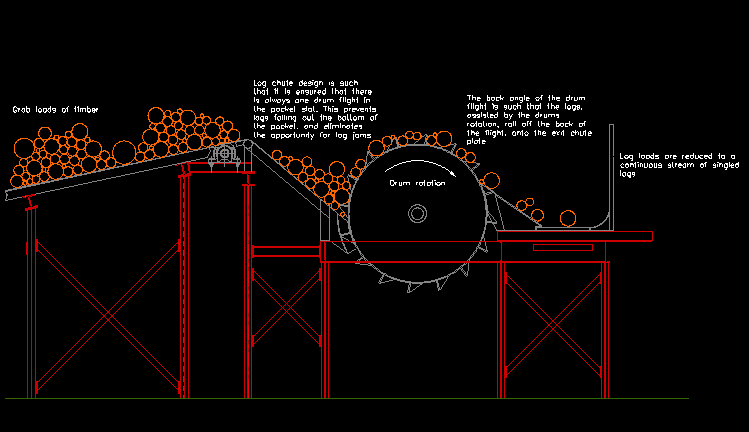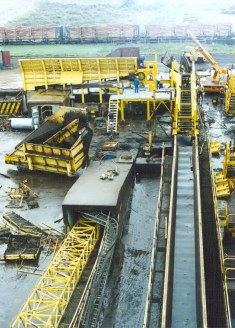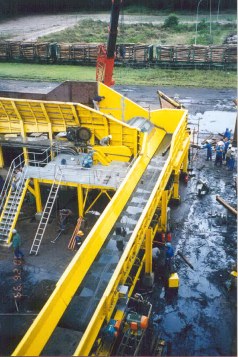Heskheath Ltd | home
Hardwood log unscrambler | Conveyor pulley standard | Effluent channel screens | Chipper casing design | Log chain design
Hardwood log unscrambler
Background
The need for log unscrambler equipment arises when a woodyard utilizes log loading equipment (either fixed gantry crane or mobile loaders) with grab sizes exceeding one ton in capacity. These log bundles, once placed on the log receiving deck, must be converted into a steady flow of logs, so as not to block the downstream feed chutes by over feeding and not permitting periods of negligible feed or reduced throughput.
This process is achieved typically using unscrambler conveyors. These systems operate by means of dropping the timber bundles into a pocket, from which the bottom logs are removed by drag chains that hook the logs, pulling continuously from the bottom of the pocket, delivering a consistent feed. An example of such a machine layout (a Jackladder unscrambler) is found on the "Areas of focus" page of this web site.
Unless carefully designed these systems are subject to severe impact loads, significant chute and conveyor deck wear and are prone to frequent log jams, ineffective unscrambling and irregular log feed.
The need for unscramblers can be avoided by changing the means of log loader feed. This can be achieved by installing a number of one ton grab loaders along the length of a horizontal log chain conveyor. The numerous small feed bundles don't require unscrambling as the loaders control the uniformity of the feed. The problem with such a system is that one can not reclaim timber efficiently from the log stacks using one ton grab machines. Such a loading philosophy raises the total log handling operating cost, as the timber must be double handled, the plant requires more operators, and there is more equipment to maintain.
The unscrambling concept

The design concept is to eliminate the jackladder chain deck, whilst maintaining a similar system geometry. The log bundles feed off the receiving deck, into a pocket formed between a feed chute and a rotating drum. The drum has welded attachments that remove the bottom most logs from the pocket delivering a uniform log feed.
The drum unscrambler has all the proven merits of a jack ladder chain unscrambler, but none of the associated maintenance and reliability problems.
The advantages
The drum has only two carrier bearings, located beyond the immediate log environment. The unscrambler has typically a multiple head shaft, each with two carrier bearings, and geared couplings. Multiple bearings comprise the tail end rollers or sprockets, and all these rotating components are located within the immediate log environment and are subject to contamination.
As the drum unscrambler rotates, so the logs rotate on it. This is unlike the jackladder system where the chains drag the logs up the inclined deck, contributing to deck wear, and an overall increase in operating drive power.
The drum log flights are the only elements subject to any wear, these are fabricated from heavy sections of temper hardened plate, and the degradation is negligible.
The unscrambler chains if well selected will deliver no more than 13000 hours of service, before complete replacement is necessary. The new chains are normally supplied with new head shaft sprockets, increasing the total refurbishment cost.
To achieve this sort of chain life the position of the chain lengths across the inclined deck are alternated during their service life, to ensure even chain wear, but does demand frequent downtime.
Log jams on the jackladder unscramblers can cause the chain strands to jump out of alignment, and once in this position the log withdrawal from the pocket is hampered, reducing potential throughput. This common occurrence is no longer an issue on the drum unscrambler.
The geometry of the log discharge from the drum onto the impact conveyor is significantly smoother than that of the discharge from jackladder unscramblers, which improves the service life of the impact conveyor belt and impact absorption buffers.
Like the jackladder unscrambler, the preferred drive on the drum is a variable speed hydraulic drive, hence loading can be controlled to suit log diameter, delivering a uniform feed. It is not uncommon to utilize the existing jackladder hydraulic drive when converting to a drum unscrambler, reducing the capital investment for an upgrade project.
The drum unscrambler with its feed and discharge chutes are fabricated in a few simple modular units reducing the installation time dramatically.
The drum unscrambler design is robust, simple, and offers easy maintenance access.

Drum unscrambler performance
The current design achieves an average throughput of 150 tons per hour of hardwood eucalyptus. The timber specification varies from 70 mm to 550 mm on diameter and 2200 mm to 3000 mm on length.
The total availability of mechanism is no less than 95%.
The total maintenance costs of the unscrambling system can be reduced by a minimum of 50 %.
Heskheath Ltd holds the provisional patents rights to the drum unscrambler design, now capable of handling timber from length 2200 mm to 5500 mm and diameter from 70 mm to 550 mm.
The timber feed rate is varied by adjusting the drum speed, typical feed rates range from 100 to 360 tons per hour.
When evaluated against a jackladder unscrambler using a Life Cycle Profit maintenance methodology, the drum unscrambler is the economic solution to log handling.

Assessment and implementation
Being modular in design a drum unscrambler is easily tailored to suit the feed timber specification and existing dimensional parameters found on any plant. It is not necessary to remain trapped by the existing woodyard technology.
Heskheath Ltd is interested in developing and installing drum systems to replace existing configurations, as well as developing green field installations.
Heskheath Ltd offer complete ownership of their proposals, from initial assessment to design, installation and commissioning.
We look forward to being of help.

Drum Installation

Drum Installation